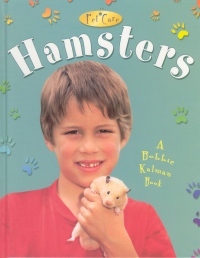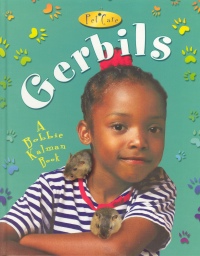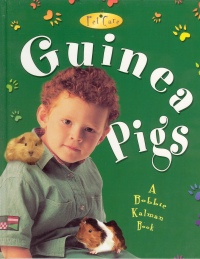| ________________
CM . . .
. Volume X Number 18 . . . . May 7, 2004
excerpt:
Readers familiar with many of the various series produced by Crabtree will probably already know what to expect from the publishing house’s new “Pet Care” series - a brief, highly readable and generously illustrated text packed into just 32 pages. The first six titles deal with some of the more popular pets amongst children. The table of contents for each book divides its contents into 14 sections with most sections occupying a single pair of facing pages. The opening section, “What are ...?”, explains what type of animal the pet is.
This same section also provides a photograph of the targeted pet and labels its major body parts. Additionally, it provides a brief explanation of the pet’s history, sometimes including how it came to be domesticated. The second section of each book is likely one of the most important, and its contents should be carefully considered before any pet is purchased because it asks the potential pet buyer a most crucial question: “The right pet for you?” In addition to describing the qualities possessed by the particular pet (Did you know that mice are very loving animals? They like living and playing with other mice. They even like to be around people!), this section also sets out the general expectations of the owner: As well as playing with and loving your pet mouse, you will have to feed it, clean its cage, and help it stay healthy. The section concludes with a checklist that is modified for each pet type:
Parents will recognize that the answers to some of the above questions can form the basis for a “contract” between themselves and their child[ren] regarding who will tend to the pet’s needs. Assuming that there have been enough positive answers to the previous checklist, the next section enlarges the choices available to the new pet owner by briefly describing some of the various breeds of the pet. For instance, “Guinea pigs galore!” provides illustrations of Abyssinians, Peruvians, Shelties and Satins while “Plenty of gerbils” shows Mongolians, Egyptian, Shaw’s jirds and Fat-tailed gerbils. The books’ fourth section describes the pets as babies and explains when they are old enough to leave their parents and be moved to new homes. This section also states when the pet is mature enough to begin to reproduce, a subtle warning to human parents who do not want their homes overrun by unexpected four-legged additions. The fifth section deals with selecting a particular animal from a pet type. In addition to informing future pet owners in broad terms about where they might find a pet, places such as animal shelters, pet stores, or breeders, this section also notes whether the pet should be a solitary purchase or should be part of a pair. (Remember that guinea pigs will get lonely, so you need at least two.) This section also has a most helpful checklist to help in selecting the right animal of that type.
Assuming that the decision has been made to purchase a pet, the sixth section focuses on “Preparing for your pets” and both enumerates and illustrates the typical supplies and equipment needed by the pet. For instance, gerbils require a cage, bedding, a box in which to sleep, a ceramic food bowl, a salt lick, fresh and packaged foods, a water bottle and some toys. The following section either expands upon how to set up the cage (in the case of pets, like mice, that must be caged) or describes how to create a welcoming environment for those pets, such as dogs, which will be allowed to roam more freely. Food and water become the focus of each book’s eighth section. A most important aspect of the information found here is a listing of what’s “Not on the menu,” those things which should not be fed to that particular pet type. For example, Citrus fruits, such as oranges or grapefruits, can make your gerbil ill. Depending upon the pet, the next two sections consider topics such as grooming (fur, teeth, claws), safe handling, training (including house training dogs and litter box training cats) before providing practical suggestions on how to play with your particular pet. Via text and supporting illustrations, the next section deals with learning to understand your pet’s verbal and nonverbal communication.
The books’ penultimate section is concerned with keeping pet owners safe from their pets (If hamsters are not handled carefully or are disturbed while they are sleeping, they may nip or bite) or with keeping the pet safe (Cats are a lot safer if they live indoors.). This section also includes a safety checklist appropriate to the pet type.
The final section speaks to the need to have a veterinarian involved in your pet’s health, and this section also includes a useful pet specific checklist of warning signs which might indicate that the pet is ill. As is common in Crabtree books, the volumes’s final page consists of a glossary of words that have been printed in bold face in the text and a brief index. These first six volumes of the “Pet Care” series certainly provide a good starting point for parents who are talking (negotiating?) with their pet-desirous children. As individual purchases for home purchase and as overall additions to school and public libraries, these initial volumes of “Pet Care” are recommended. Recommended. Dave Jenkinson teaches courses in children’s and adolescent literature in the Faculty of Education, the University of Manitoba. Dave could have used the “Pet Care” series when his sons were growing up and the family dwelling housed at various times rabbits, dogs, cats, cockatiels, a gerbil and a garter snake.
To comment
on this title or this review, send mail to cm@umanitoba.ca.
Copyright © the Manitoba Library Association. Reproduction for personal
use is permitted only if this copyright notice is maintained. Any
other reproduction is prohibited without permission.
NEXT REVIEW |
TABLE OF CONTENTS FOR THIS ISSUE
- May 7, 2004.
AUTHORS |
TITLES |
MEDIA REVIEWS |
PROFILES |
BACK ISSUES |
SEARCH |
CMARCHIVE |
HOME |





